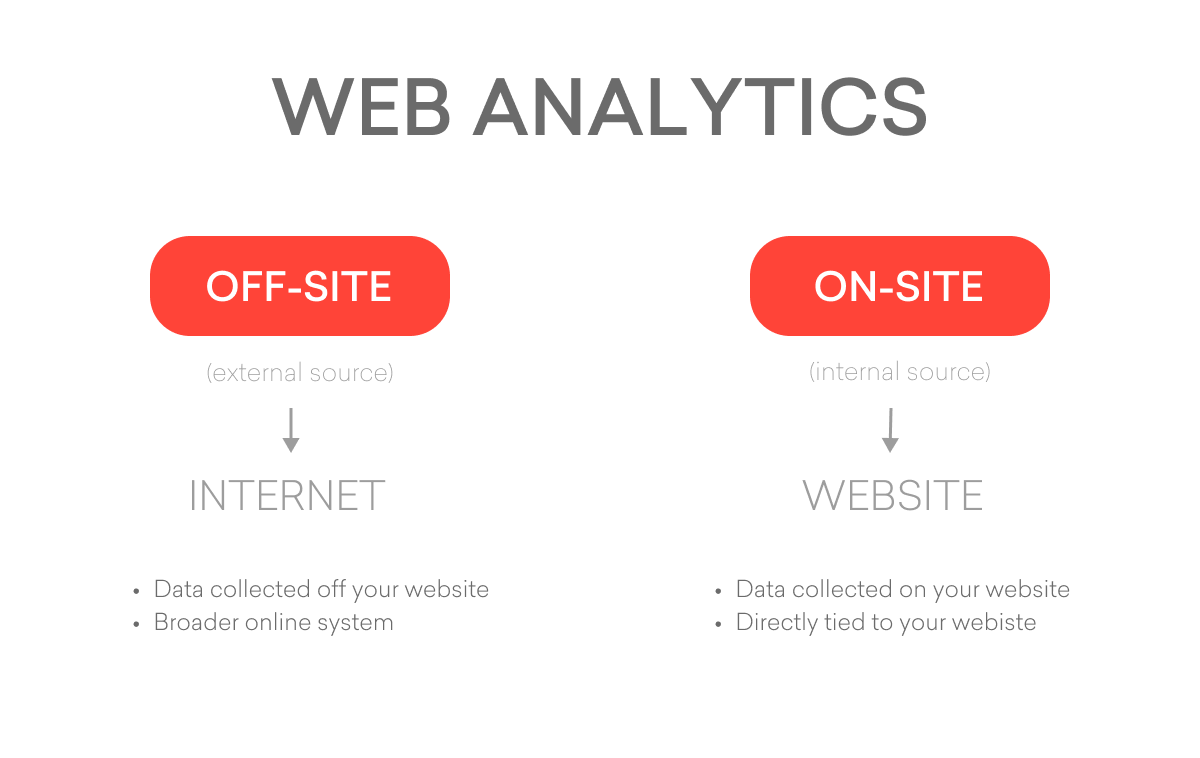Data is crucial for any type of business. Businesses that make decisions and conclusions solely on presumptions and experience miss out on some BIG opportunities. What worked yesterday, might not work today.
Data-driven businesses can profit from data by staying ahead of their competition, identifying exciting opportunities, and being prepared for anything the fast-paced market has to throw at them tomorrow. That’s why it’s important to harness the power of data.
And there are plenty of tools out there that’ll help you gather key data and insights ─ both from your website and off ─ whether it’s related to your business directly, trends in the industry, competition, etc.
Let’s dive into web analytics ─ what it is, how it’s different from digital marketing analytics, why it’s important, and what the common tools and issues are.
What is Web Analytics?
Web analytics is a collection of data collected from the web in the form of reports, and it provides a useful and usually practical way to analyze collected data.
Web analytics is great because nowadays, we can collect so much data from the web. But, it’s important to remember that web analytics data is only as useful as the person analyzing it. Without a professional standing behind it, it’s essentially useless.
When talking about web analytics, it doesn’t only refer to data collected from the website. There are two main categories: off-site, and on-site web analytics.
Off-site Web Analytics
Off-site web analytics refers to data collected from other (external) sources ─ third-party sources. This data is usually a collection of information irrespective of your website presence since these tools look at a broader online ecosystem.
Let’s say you need information about how you stack against your competitors, off-site web analytics tools will help you find that out.
On-site Web Analytics
On-site web analytics refers to data collected from your website ─ a unique set of data directly tied to your website. On-site web analytics include information about your website visitors, specifically how they interact with your website (user behavior).
The leader in “on-site web analytics tools” is Google Analytics. Google Analytics helps you find out anything from ─ how long your visitors stayed on the website, how many times a page was viewed, whether there were new or returning visitors, which sources re-directed visitors to your website, etc. But many more alternative tools help you achieve just that.

The Difference Between Web Analytics and Digital Marketing Analytics
It’s a common mistake that the terms web analytics and digital marketing analytics are put in the same basket since web analytics is also used in marketing.
The main difference is that digital marketing analytics provide data that focuses on customers, and look at data from other sources, such as social media and e-mail. In other words, digital marketing analytics provide insights from the marketing point of view ─ one’s effectiveness of marketing efforts.
But, don’t be mistaken ─ web analytics is also an important part of measuring the effectiveness of businesses’ marketing activities since a website is most commonly the “house” of one’s online presence.
Importance and Benefits of Web Analytics
Understanding User Behaviour
Even though it’s easy to track how many users have visited your website over time, it’s useless if you don’t know how they behaved on your website. It’s crucial to understand why they do what they do.
Let’s say you have an e-commerce store. If you don’t know the information on key actions such as, if they completed their purchase or if they might have dropped out in the process and where, you’re missing out on business growth.
Web analytics can help you understand how users interact with your site, and give you pretty good directions on why visitors did what they did. By having the right web analytics tools that’ll help you gather user behavior data, businesses gain a deeper understanding of their customers.
Sometimes the best feedback you can get is behavior.
Optimizing Website Performance
Who wouldn’t want to optimize for the best possible website performance? There are many ways web analytics can help you figure out what works, and what simply doesn’t ─ whether it’s insights on what gives the most value to your prospects or what parts of your website are getting in the way of achieving your business goals. This essentially involves your website design, content, functionality, and visibility.
Getting the right insights to optimize your website performance can help you improve your website’s overall user experience, online visibility, and conversion rates.
Enhancing Marketing Strategies
With web analytics, you are getting insights into many opportunities since you can get so much data about your prospects, competition, trends, and the overall effectiveness of your marketing efforts.
These insights allow you to reconsider your current strategy, and make data-driven decisions that can enhance your marketing strategies for better results.
Measuring the Success of Business Goals
And you can’t enhance your marketing strategies without measuring your business goals. What is your business trying to achieve? Are your marketing efforts contributing to your business goals? Web analytics tools have the answer (but it will need a little bit of your help, too).
Types of Web Analytics Tools
Traditional Web Analytics Tools
When we think of a traditional web analytics tool, a certain tool pops to mind. Google Universal Analytics (now Google Analytics 4) has been the king of qualitative on-site web analytics tools.
These traditional on-site web analytics tools often provide insights into website traffic such as ─ page views, time on page, and other user data. And there are many tools available that will help you track these data.
Behavioural Analytics Tools
Behavioral analytics tools tackle the qualitative aspect of user website behavior data. The most popular ones are Hotjar, Yandex Metrica, and Microsoft Clarity. These tools provide an overview of how your users interact with your website from a visual perspective ─ heatmaps, session recordings, and more.
By seeing actions users take on your website, you can understand their experience and uncover possible issues such as bad user experience or bugs on your website.
SEO Analytics Tools
SEO analytics tools are helpful from your website’s search engine visibility perspective. These tools help you uncover keyword performance, search trends, the organic performance of your competitors, backlink profiles, and more. In their basis, they are most often used for keyword research, on-page optimization, technical website audits, and backlink analysis.
The most popular SEO analytics tools are Ahrefs, SEMRush, and Moz, and all of these tools have the same approach to what you’ll uncover but are different in their way.
A/B Testing Tools
A/B testing tools allow you to test these different versions of web pages and assess which elements are successful in engaging or confusing visitors. By making changes based on these results, you can improve your website and convert more visitors into customers.
By conducting split tests and analyzing user behavior, A/B testing tools provide valuable insights into how people respond to various versions of a product, such as different website messaging and design. This information can be used to develop new features or pages and enhance existing ones, leading to the overall improvement of the product.
Common Issues with Web Analytics
Lack of Knowledge
Web analytics can be overwhelming and complex, and it takes a lot of skill and knowledge to master. Some of these web analytics tools will give you so much information that you won’t even know what to look at first, and what the things you’re looking at really mean. As a result, the data will very likely be misinterpreted.
It takes someone with a deep understanding of the various metrics and how they relate to each other, and what influence other factors have on your data to make sense of it all.
Lack of Clear Business Objectives
To gather the right insights that will help your business grow and succeed, you will need to know what the business is trying to achieve. And you can’t just expect valuable insights if you don’t even know what data you need to look at.
It is important to remember that most of these web analytics tools were made for the masses, and thus have so much data, so it’s easy to fall into the “report something just because you can” hole.
Data Privacy and Security Issue
Nowadays, there are many privacy laws, and as such oblige businesses to adjust their data processing methods and respect their users’ rights. Companies must pay close attention to how they collect and process user data, meaning they also need to have a deep understanding of how the tools and platforms they are using comply or don’t comply with those laws.
How you store user data should also be transparent so users know what data you’re collecting and what is done with it. This also means businesses need to know exactly what cookies their platforms store in their users’ browsers.
For example, according to GDPR users must have the option to opt-out of tracking, specifically tracking cookies. By GDPR EU: “To comply with the regulations governing cookies under the GDPR and the ePrivacy Directive you must:
- Receive users’ consent before you use any cookies except strictly necessary cookies.
- Provide accurate and specific information about the data each cookie tracks and its purpose in plain language before consent is received.
- Document and store consent received from users.
- Allow users to access your service even if they refuse to allow the use of certain cookies
- Make it as easy for users to withdraw their consent as it was for them to give their consent in the first place.”
There is also a data security issue ─ unauthorized access or theft ─ and when data leaks or breaches occur, it’s a clear violation of users’ privacy, so web analytics tools and internal procedures and policies need to be safe, minimizing the risk of malicious attacks and data leaks.
Data Accuracy Issue
Not all web analytics data will be accurate, and we need to address that. The most common practice with on-site web analytics is using client-side tracking because it is inexpensive and fast, but it relies on first or third-party cookies. Also, with ad blockers around, third-party cookies will not provide you with complete data.
There is also the ones’ knowledge to track on-site web analytics data correctly because you must also know how to detect and configure data anomalies when they occur.
There are many more issues with on-site and off-site web analytics data accuracy that can be discussed, it’s a never-ending hole ─ but it certainly does not mean web analytics tools are useless.
By embracing web analytics, businesses can unlock the power of data to gain a competitive edge, anticipate market trends, and adapt to the unpredictable nature of the business environment. Web analytics tools provide invaluable data and insights, both from on-site and off-site sources, enabling businesses to understand user behavior, optimize website performance, enhance marketing strategies, and measure the achievement of their goals.
While there are obstacles to navigate, the rewards of a data-driven approach far outweigh the risks, paving the way for innovation, success, and a sustainable competitive advantage.
Our Performance Marketing team is ready to tackle all your performance marketing needs ─ from research and goal definition to strategic implementation and optimization, we cover it all. Ready to elevate your business? Contact us, and let’s make it happen together.




